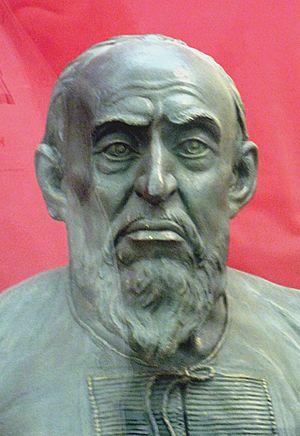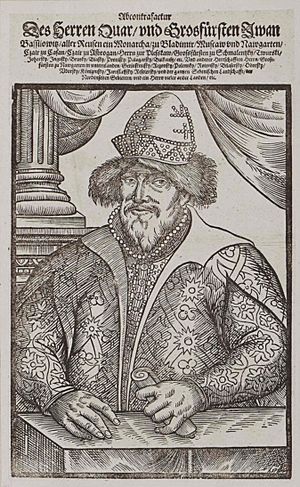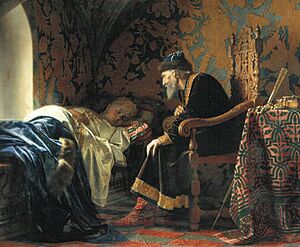Ivan the Terrible facts for kids
Quick facts for kids Ivan IV |
|||||
|---|---|---|---|---|---|

A reconstruction of Ivan IV's face by Mikhail Gerasimov
|
|||||
| Tsar of Russia | |||||
| Reign | 16 January 1547 – 28 March 1584 | ||||
| Coronation | 16 January 1547 | ||||
| Predecessor | Monarchy established | ||||
| Successor | Feodor I | ||||
| Grand Prince of Moscow | |||||
| Reign | 3 December 1533 – 16 January 1547 | ||||
| Predecessor | Vasili III | ||||
| Successor | Himself as Tsar of Russia | ||||
| Born | 25 August 1530 Kolomenskoye, Grand Duchy of Moscow |
||||
| Died | 28 March [O.S. 18 March] 1584 (aged 53) Moscow, Tsardom of Russia |
||||
| Burial | Cathedral of the Archangel, Moscow | ||||
| Spouses |
See list
Anastasia Romanovna
Maria Temryukovna Marfa Sobakina Anna Koltovskaya Anna Vasilchikova Vasilisa Melentyeva Maria Nagaya |
||||
| Issue more... |
See list
|
||||
|
|||||
| Dynasty | Rurik | ||||
| Father | Vasili III of Russia | ||||
| Mother | Elena Glinskaya | ||||
| Religion | Russian Orthodox | ||||
Ivan IV Vasilyevich (born August 25, 1530 – died March 28, 1584) is often known as Ivan the Terrible. In Russian, his nickname Grozny means "Formidable" or "Fearsome." He was the Grand Prince of Moscow from 1533 to 1547. Then, he became the very first Tsar of Russia from 1547 until his death in 1584.
Ivan became Grand Prince when he was only three years old, after his father, Vasili III, passed away. At age seventeen, he was crowned Tsar, which is like an emperor. This established the Tsardom of Russia, with Moscow as its most important city.
Ivan's time as ruler changed Russia from a medieval state into a large empire. This came with a high cost for the people and the economy. Ivan conquered new lands, like the Khanate of Kazan and the Khanate of Astrakhan. This made Russia a huge country with many different groups of people. He also created a system of government workers to manage these new areas.
Ivan started the Livonian War, which was a long and difficult conflict. This war caused a lot of damage in Russia. However, it also helped Ivan gain more control over Russia's powerful noble families. He even carried out a harsh purge against some of them, known as the Oprichnina.
Ivan was a skilled diplomat and supported arts and trade. He also founded Russia's first publishing house. Many ordinary people liked Ivan, except for those in areas like Novgorod, who suffered greatly during his rule. Historical records show that Ivan had a complex personality. He was smart and religious, but he also had periods of paranoia and intense anger. Sadly, his eldest son, Ivan Ivanovich, died before him. This left his less experienced son, Feodor Ivanovich, to become Tsar. Feodor's rule eventually led to the end of Ivan's family line and a difficult period in Russian history called the Time of Troubles.
Contents
Ivan's Family Life
Marriages and Children

Ivan IV had several marriages and many children. Here are some of his most notable marriages and children:
- Anastasia Romanovna (married 1547–1560, died):
- Tsarevna Anna Ivanovna (1548–1550)
- Tsarevna Maria Ivanovna (1551–died young)
- Tsarevich Dmitri Ivanovich (1552–1553)
- Tsarevich Ivan Ivanovich (1554–1581)
- Tsarevna Eudoxia Ivanovna (1556–1558)
- Tsar Feodor I of Russia (1557–1598)
- Maria Temryukovna (married 1561–1569, died):
- Tsarevich Vasili Ivanovich (1563–1563)
- Marfa Sobakina (married 1571, died shortly after)
- Anna Koltovskaya (married 1572, later sent to a monastery). This was his last marriage approved by the church.
- Anna Vasilchikova (married 1575/76, later sent to a monastery)
- Vasilisa Melentyeva (possibly a partner around 1575, but some historians believe she might be a fictional character from the 19th century)
- Maria Nagaya (married since 1580):
- Tsarevich Dmitri Ivanovich (1582–1591)
Ivan's Religious Beliefs

Ivan was a very religious man and a strong follower of Christian Orthodoxy. He believed that the ruler had a special right from God to have unlimited power. Some historians think that Ivan's strong religious beliefs influenced his actions. He saw himself as God's representative on Earth. This meant he felt it was his sacred duty to punish those he believed were wrong.
How Ivan IV Died
Ivan passed away on March 28, 1584, after having a stroke. He was playing chess at the time. After Ivan's death, his son Feodor became the new Tsar. Feodor did not have any children, and when he died in 1598, it marked the end of Ivan's family line. This led to a period of great instability in Russia called the Time of Troubles.
What Ivan Looked Like
We don't know exactly what Ivan looked like because most pictures of him were made after he died. These pictures often show what the artist imagined. In 1567, an ambassador named Daniel Prinz von Buchau described Ivan. He said Ivan was "tall, stout and full of energy." He also noted Ivan's "big, observing and restless" eyes. His beard was "reddish-black, long and thick."
Another person, Ivan Katyryov-Rostovsky, described Ivan as having an "unpleasant face" with a "long and crooked nose." He also said Ivan was tall and strong, with broad shoulders and a narrow waist.
In 1963, scientists studied Ivan's remains. They found that he was about 178 cm (5 feet 10 inches) tall and weighed about 85–90 kg (187–198 pounds) when he died. They also found that he had some bone diseases in his later years. This made it hard for him to move.
Ivan's Legacy

Ivan completely changed how Russia was governed. He created the Oprichnina, a special group that answered only to him. This helped him gain more power and limit the traditional influence of the noble families, called boyars. From then on, the Russian Tsar had almost total power. Ivan also gave important positions to his supporters, even if they were not from the highest noble families. His system of local government, which combined local and central officials, worked well and lasted a long time.
Ivan's military efforts to expand Russia's borders were not always successful. However, they helped Russia connect more with Europe through trade, politics, and culture. Later, Peter the Great built on these connections to make Russia a major European power. By the time Ivan died, his empire stretched from the Caspian Sea to Western Siberia.
Ivan's management of Russia's economy was not very good. He inherited a government that was already in debt. To pay for his wars, he created many new taxes, which made people unhappy. The constant wars used up a lot of Russia's people and resources. This left the country almost ruined. After Ivan's death, the struggling economy contributed to the end of his family's rule and led to the "Time of Troubles."
Ivan's strong personality and desire for absolute power shaped the role of the Tsar. He believed the Tsar was only answerable to God, not to any earthly authority. This idea of absolute rule continued in Russia for a long time. In modern Russia, some people have even campaigned to make Ivan IV a saint, but the Russian Orthodox Church has not supported this idea.
Ivan in Popular Culture
Ivan the Terrible has appeared in many movies, books, and plays:
- The famous Soviet filmmaker Sergei Eisenstein made two films about Ivan's life, called Ivan the Terrible.
- Conrad Veidt played Ivan in the film Waxworks.
- Tsar is a Russian drama film from 2009.
- In the movie Night at the Museum: Battle of the Smithsonian, Ivan was played by Christopher Guest.
- He is a character in the novel Russka by Edward Rutherfurd.
- Ivan is also a major character in the popular Soviet comedy film Ivan Vasilievich: Back to the Future.
- He appears in The Ringed Castle, a historical fiction novel by Dorothy Dunnett.
- Ivan the Terrible is one of the playable teams in the video game Age of Empires III.
- He was also portrayed on BBC Radio 4 in a radio play called Ivan the Terrible: Absolute Power.
Images for kids
-
Birth of Ivan Ivanovich, son of Ivan the Terrible and Anastasia Romanovna, from Illustrated Chronicle of Ivan the Terrible
-
Portrait of Ivan IV by Viktor Vasnetsov, 1897 (Tretyakov Gallery, Moscow)
-
Ivan the Terrible Showing His Treasures to Jerome Horsey by Alexander Litovchenko (1875)
-
Ioannes Basilius Magnus Imperator Russiae, Dux Moscoviae, by Abraham Ortelius (1574)
See also
 In Spanish: Iván IV de Rusia para niños
In Spanish: Iván IV de Rusia para niños











